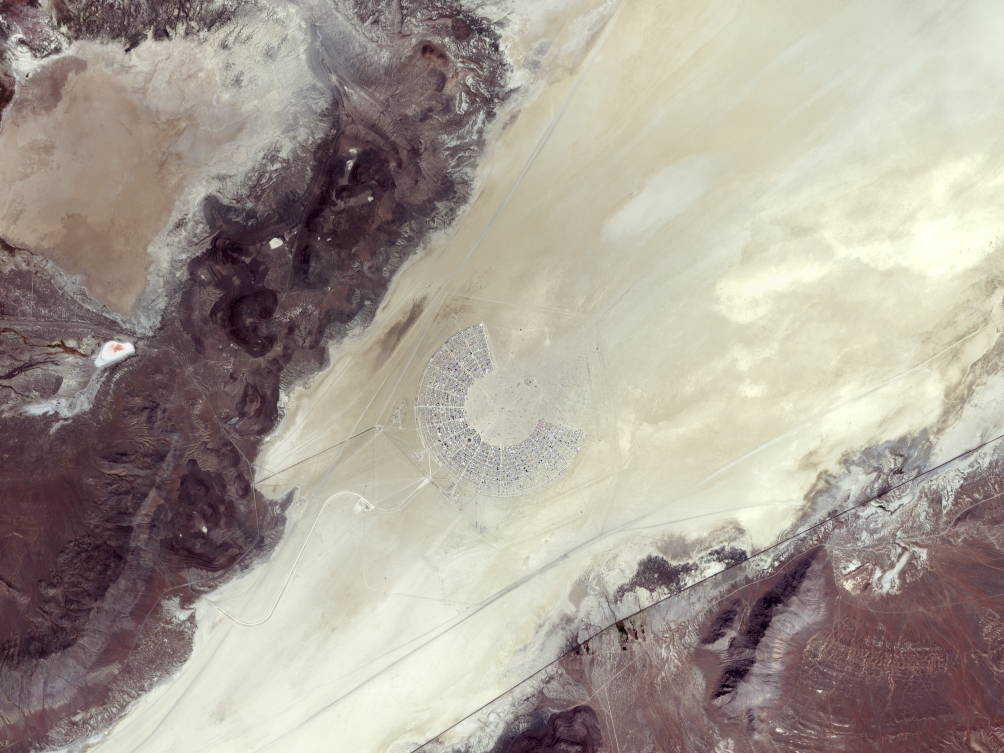La missione Copernicus Sentinel-2 ha ripreso una immagine ricordo del festival Burning Man nel deserto di Black Rock, in Nevada.
Con una superficie di circa 2600 kmq, il deserto Black Rock si trova nel Nevada nord-occidentale ed è una regione arida costituita da letti di lava e pianure alcaline. Acquisita il 26 agosto 2024, l'immagine mostra l'area di sabbia bianca che si trova nella parte sud-occidentale del deserto e dove ogni anno si svolge il festival Burning Man.
Oltre 70.000 persone si sono riunite dal 25 agosto al 2 settembre al Black Rock per l'evento allestito nel deserto. Questa immagine, acquisita da quota orbitale il secondo giorno dell'evento, mostra l'area dei camper e delle tende raggruppati assieme in occasione del festival di arte ed auto-espressione, della durata di una settimana, che include – tra gli altri - musica, sbalorditive installazioni artistiche, sculture sperimentali interattive ed auto d'arte.
Il nome deriva dalla sua cerimonia di maggior importanza caratterizzata dal rogo simbolico di una grande effigie di legno, denominata l'Uomo, situata al centro esatto di questo insediamento temporaneo.
Come la maggior parte del Nevada, il deserto Black Rock si trova all'interno del deserto Great Basin, il più grande degli Stati Uniti, costituito da una distesa arida di circa 492.000 kmq. Il deserto Great Basin è noto per il suo sistema di drenaggio interno, in cui le precipitazioni non raggiungono mai uno sbocco verso il mare.
L'allungamento e il sollevamento della crosta terrestre occorso negli ultimi 17 milioni di anni hanno portato ad un modello ricorrente di valli e aspre catene montuose nord-sud, come quelle visibili di colore marrone intorno all'area sabbiosa.
La missione Copernicus Sentinel-2 si basa su una costellazione di due satelliti identici che volano nella stessa orbita, ma a 180° di distanza angolare, riuscendo in tal modo ad ottenere la copertura di tutte le acque terrestri e costiere della Terra ogni cinque giorni.
Il 5 settembre 2024 il terzo satellite della missione, Sentinel-2C, è stato lanciato in orbita per unirsi ai suoi fratelli e garantire alla missione la fornitura continua di dati ad alta risoluzione.
A meno di due settimane dal lancio Sentinel-2C ha consegnato le sue sbalorditive prime immagini, dimostrando che il satellite non solo funziona come previsto, ma ha già superato le aspettative.
Scarica immagine HiRes (614,24 KB - .JPG)
Scarica immagine HiRes (17,31 MB - .TIF)
---
Burning Man festival
The Copernicus Sentinel-2 mission has snapped a souvenir of the Burning Man festival in the Black Rock desert in Nevada.
Covering about 2600 sq km, the Black Rock Desert is an arid region of lava beds and alkali flats in northwestern Nevada. The picture, acquired on 26 August 2024, captures the white, sandy area in the southwestern part of the desert, where the Burning Man festival takes place annually.
Over 70 000 people gathered from 25 August to 2 September at Black Rock for the desert-based event. This image, taken from orbit on the second day of the event, shows the area of camper vans and tents grouped together for the week-long art and self-expression festival, which involves music, stunning art installations, experimental and interactive sculptures, and art cars, among others.
The name comes from its culminating ceremony, featuring the symbolic burning of a large wooden effigy, referred to as the Man, located at the dead centre of this temporary settlement.
Like most of Nevada, the Black Rock Desert lies within the Great Basin Desert, the largest in the US, covering an arid expanse of some 492 000 sq km. The Great Basin is noted for its internal drainage system, in which precipitation never reaches an outlet to the sea.
Stretching and uplifting of Earth's crust over the past 17 million years have resulted in a recurrent pattern of valleys and rugged north-south mountain ranges, like those visible in brown around the sandy area.
The Copernicus Sentinel-2 mission is based on a constellation of two identical satellites flying in the same orbit but 180° apart, to cover all of Earth’s land and coastal waters every five days.
On 5 September 2024, the third satellite in the mission, Sentinel-2C, was launched into orbit to join its siblings and ensure the continuous provision of high-resolution data from the mission.
Less than two weeks after launch, Sentinel-2C has delivered its stunning first images, proving that the satellite is not only working as expected, but has already surpassed expextations.
[Credits: contains modified Copernicus Sentinel data (2024), processed by ESA - Translation: Gianluca Pititto]




